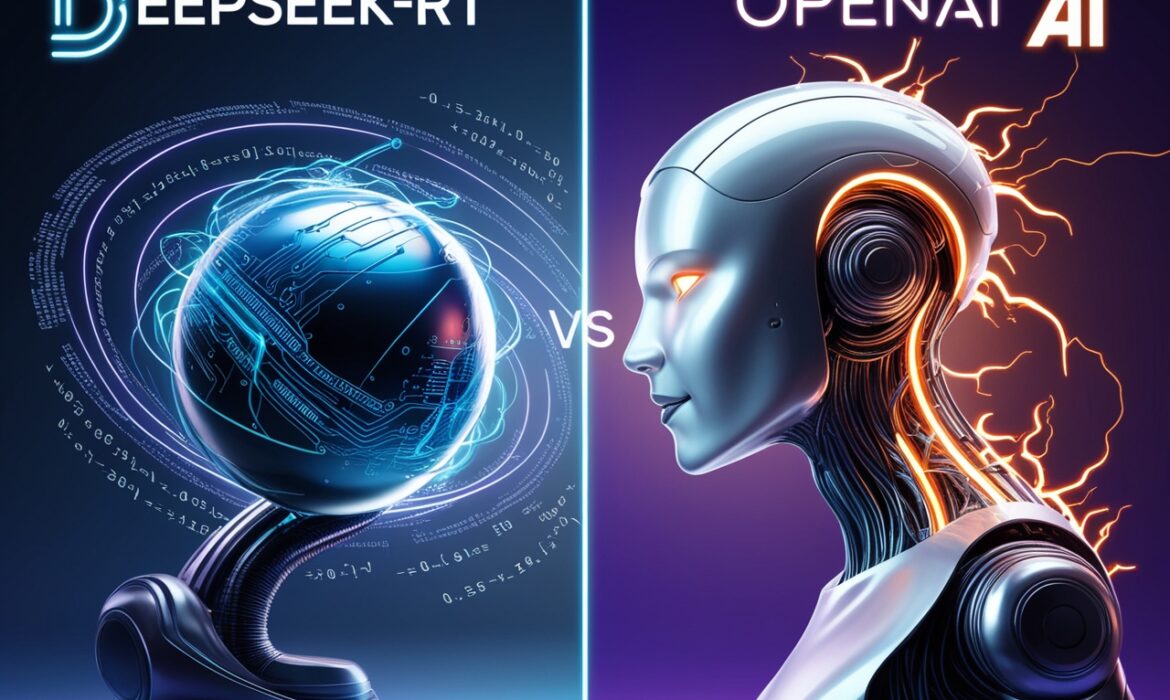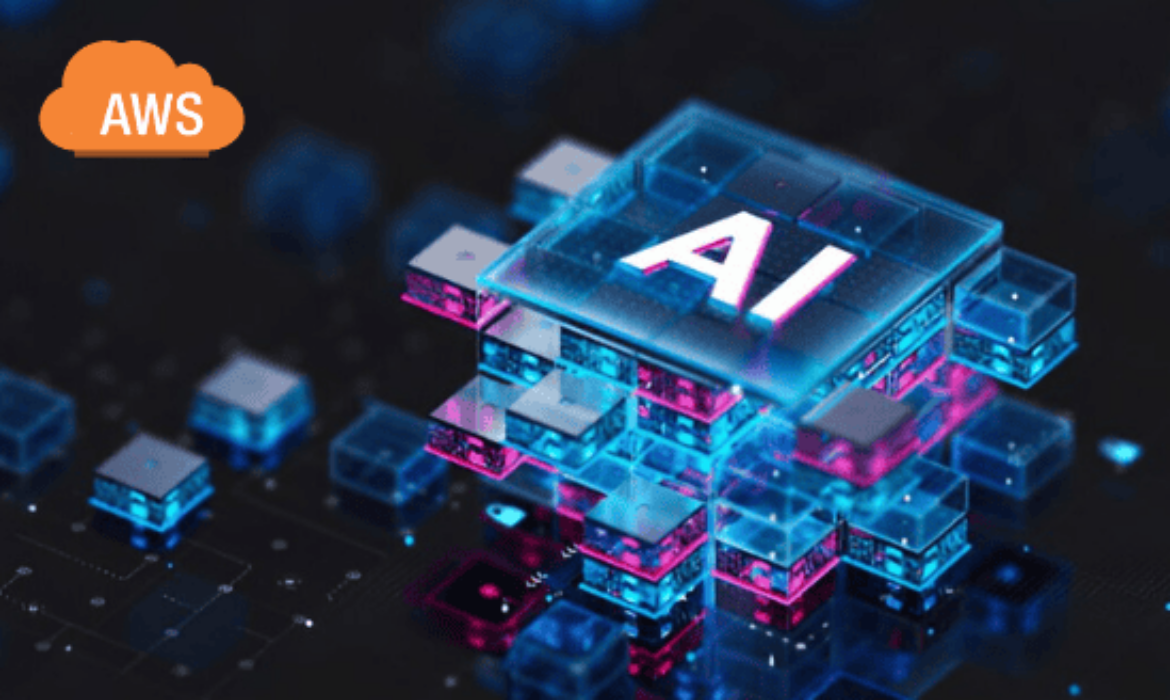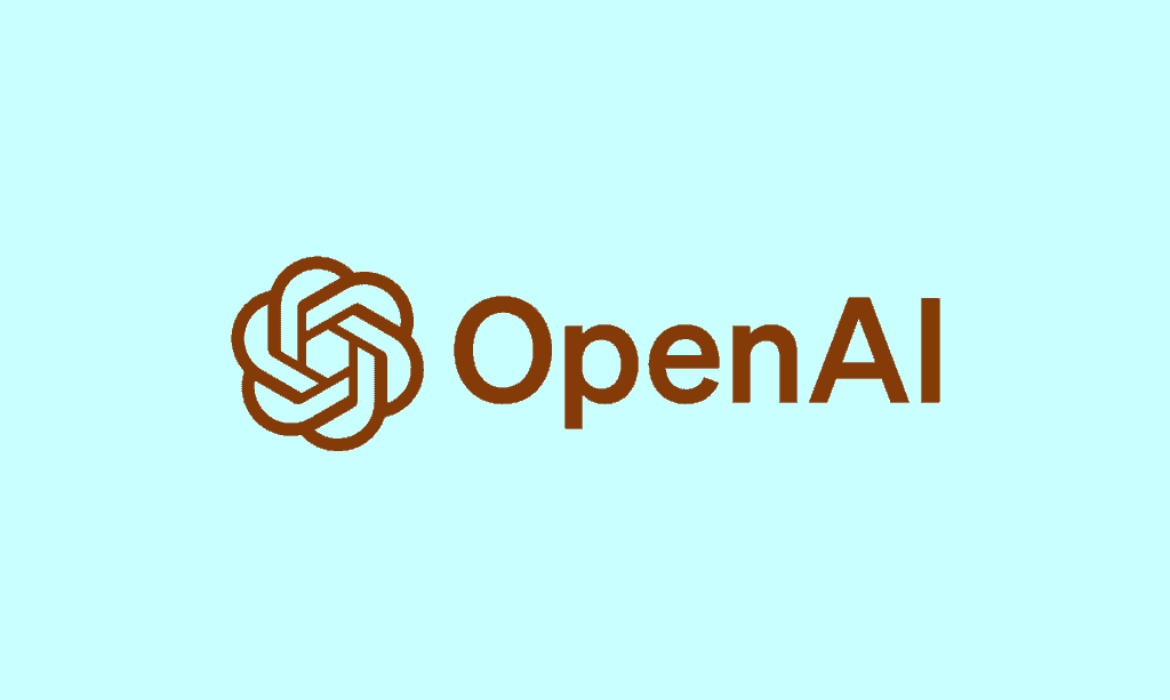DeepSeek-R1 Vs OpenAI: A Clash of Specialized and Versatile AI Models
The emergence of Deepseek, particularly its advanced reasoning model Deepseek R1, has sparked considerable debate within the tech community as it rapidly ascends to become a top-rated free app on the US Apple App Store. Renowned for its innovative application of large-scale reinforcement learning, Deepseek distinguishes itself from traditional AI leaders like OpenAI by delivering impressive results with a more efficient and cost-effective approach. While OpenAI reportedly poured over $100 million into developing its GPT-4 model, Deepseek claims to have achieved comparable breakthroughs in just two months for only $6 million. This stark contrast highlights a significant shift in the AI landscape towards open-source models that are increasingly capable of rivaling proprietary systems.
As Deepseek gains momentum, it is prompting a re-evaluation of established AI development strategies, emphasizing the potential for transformative outcomes through efficient resource utilization and innovative methodologies. The rise of open-source innovation is intensifying the competition with proprietary frameworks, ultimately reshaping the future of artificial intelligence and redefining the trajectory of technological advancement. The ongoing battle between these two approaches suggests a dynamic shift in how AI technologies may be developed and deployed in the coming years.
Why is DeepSeek a Game Changer?
DeepSeek’s emergence in the AI landscape coincides with a critical juncture amid the ongoing tech cold war between the U.S. and China. U.S. export controls on advanced technologies, particularly Nvidia chips, have severely restricted China’s access to cutting-edge AI hardware. Consequently, many Chinese companies have shifted their focus to developing downstream applications, relying on existing models rather than investing in foundational AI systems. This pivot has fostered dependency on Western technologies and created an innovation gap.
With DeepSeek’s rise, there is potential for a significant shift in this dynamic. The startup has demonstrated that substantial AI advancements can be achieved with far less investment than that of proprietary models like OpenAI’s GPT-4. By leveraging large-scale reinforcement learning and efficient resource management, DeepSeek challenges the belief that success in AI development is solely dependent on access to advanced hardware and vast financial resources. This approach not only opens the door for other players in constrained environments but also encourages a rethinking of global AI strategies, promoting open-source methodologies and community-driven initiatives over proprietary technology.
Cost Efficiency: The Economic Advantage of DeepSeek-R1
DeepSeek’s emergence in the AI landscape coincides with a critical juncture amid the ongoing tech cold war between the U.S. and China. U.S. export controls on advanced technologies, particularly Nvidia chips, have severely restricted China’s access to cutting-edge AI hardware. Consequently, many Chinese companies have shifted their focus to developing downstream applications, relying on existing models rather than investing in foundational AI systems. This pivot has fostered dependency on Western technologies and created a gap in innovation.
With DeepSeek’s rise, there is potential for a significant shift in this dynamic. The startup has demonstrated that substantial AI advancements can be achieved with far less investment than that of proprietary models like OpenAI’s GPT-4. By leveraging large-scale reinforcement learning and efficient resource management, DeepSeek challenges the belief that success in AI development is solely dependent on access to advanced hardware and vast financial resources. This approach not only opens the door for other players in constrained environments but also encourages a rethinking of global AI strategies, promoting open-source methodologies and community-driven initiatives over proprietary technology.
OpenAI’s Multifunctional AI Development Strategy
OpenAI’s strategy for AI development focuses on creating versatile, multifunctional models such as GPT-4, capable of addressing a broad spectrum of tasks, including natural language processing and problem-solving in various fields. However, this level of flexibility comes with a significant price tag. OpenAI has reportedly invested over $100 million in the development of GPT-4, a substantial expenditure aimed at ensuring the model performs well across diverse applications. Yet, these high costs can pose barriers to accessibility for smaller competitors.
Despite the cutting-edge nature of OpenAI’s models, their resource-intensive requirements have ignited discussions regarding sustainability and efficiency. As the demand for specialized and cost-effective AI solutions rises, OpenAI’s focus on multifunctionality may encounter competition from more streamlined and affordable alternatives, such as DeepSeek.
Performance Comparison: A Comparative Analysis
Mathematical Reasoning and Coding Tasks
DeepSeek-R1 has shown superior performance in mathematical reasoning and coding tasks, achieving a notable 79.8% accuracy on the AIME 2024 benchmark, slightly outperforming OpenAI’s models which achieved 79.2%.
Versatility and General-Purpose Capabilities
OpenAI’s models, like GPT-4, are celebrated for their versatility and proficiency across a wide array of tasks. They excel in natural language understanding, translation, and creative writing.
Multitask Language Understanding
In the Massive Multitask Language Understanding (MMLU) benchmark, OpenAI’s models have demonstrated higher accuracy rates than DeepSeek-R1, highlighting their extensive knowledge base and competence in diverse subjects.
Future Trends: What Lies Ahead for AI Models
The future of AI models is set for a transformative shift, driven by key trends shaping the industry. Multimodal AI, which integrates text, images, audio, and video, is emerging as a game-changer, enabling more natural interactions and improving accuracy. This evolution toward versatile AI systems will redefine their role in daily life and business operations, making them more adaptive and impactful.
In parallel, cost efficiency and open-source development are expected to democratize AI access, reducing dependency on expensive proprietary systems. Smaller, energy-efficient models will gain traction, fostering sustainability and broader adoption. Additionally, as market fluctuations influence the U.S. dollar’s value, innovation from diverse players will accelerate, reshaping competitive dynamics within the AI landscape.
Agentic AI in Action: Transformative Applications Across Various Sectors
An AI Agent is an advanced system designed to operate autonomously, executing tasks with minimal human involvement. It represents a leap into the automation of artificial intelligence, capable of solving problems independently with little to no guidance. This autonomy allows AI Agents to perform diverse functions across various sectors, significantly boosting efficiency and accuracy.
For example, in the automotive industry, AI Agents drive autonomous vehicles that can navigate through intricate traffic conditions, making instantaneous decisions to ensure safety and dependability. In the financial sector, these agents analyze vast amounts of economic data to provide personalized investment advice, assisting users in optimizing their portfolios. By leveraging AI Agents, industries are undergoing transformative changes, as these systems streamline operations and enhance decision-making through data-driven insights.
The Operational Framework of AI Agents
AI agents function through three core phases: perception, reasoning, and action. In the perception phase, they gather data from their surroundings using sensors like cameras and microphones. For example, temperature sensors in a smart home monitor indoor conditions and adjust settings based on external weather changes. This data collection builds a comprehensive understanding of their environment, enabling the agents to respond effectively.
In the reasoning phase, AI analyzes the collected data using advanced algorithms, such as machine learning and natural language processing, to identify optimal actions. During the action phase, these decisions are executed, like adjusting a thermostat or offering tailored advice. Feedback from their actions allows AI agents to learn and improve over time. By seamlessly integrating these phases, AI agents enhance efficiency and automation, paving the way for intelligent systems to play a transformative role in everyday life.
Striking the Balance: Empowering Agentic AI
The conversation around autonomy and assistance in agentic AI centers on achieving the right equilibrium between empowering users and maintaining control. Autonomy refers to AI systems capable of independent functioning, decision-making, and adaptive learning from their environments—a significant leap from traditional AI reliant on explicit user prompts. While this independence can enhance efficiency and spur innovation, it also raises concerns about accountability, user trust, and the potential erosion of personal agency.
Conversely, assistance-oriented AI emphasizes collaboration, working alongside humans to support decision-making without overshadowing it. This approach amplifies human abilities, fostering creativity, productivity, and a sense of empowerment. By nurturing a cooperative dynamic between humans and AI, we can achieve a harmonious balance that safeguards human agency while delivering peak performance. Ultimately, the goal is to design AI systems that cultivate a symbiotic relationship, driving benefits for individuals and society alike.
Challenges in Adopting Agentic AI Systems
- Accountability and Ethical Issues: A significant challenge in adopting agentic AI systems is the difficulty in understanding their autonomous decision-making processes, which raises concerns about transparency and fairness. Additionally, the presence of embedded biases in AI models can lead to discriminatory outcomes, ultimately undermining trust among users and society.
- Erosion of Human Agency: Another critical issue is the potential erosion of human agency, as over-reliance on autonomous systems may lead users to become passive participants in decision-making. This dependence can diminish essential skills such as critical thinking and problem-solving. Furthermore, users may experience feelings of exclusion, which can undermine their confidence in the technology.
- Security and Privacy Risks: Security and privacy are pressing concerns, given that agentic AI systems require access to extensive datasets. This requirement makes them attractive targets for cyberattacks, and vulnerabilities in their decision-making processes can be exploited. Moreover, the need for large volumes of data increases the risk of privacy breaches.
- Legal and Regulatory Challenges: The legal and regulatory landscape for agentic AI remains inconsistent and underdeveloped, complicating the determination of accountability for failures. Varying regulations across different regions can hinder deployment and innovation, creating further obstacles for the responsible implementation of these systems.
Collaborative Solutions Needed
To effectively address these challenges, it is essential to foster collaborative efforts among developers, policymakers, and stakeholders. This collaboration should focus on establishing ethical frameworks, enhancing transparency in AI operations, and implementing robust security measures. By addressing these issues collectively, we can better harness the potential of agentic AI while mitigating associated risks.
Transformative Applications of Agentic AI Across Industries
Healthcare
Agentic AI is transforming the healthcare sector by efficiently and accurately analyzing extensive medical data. It plays a vital role in early disease detection by meticulously processing imaging data and patient records. AI-driven tools are also utilized to develop personalized treatment plans, and customize therapies to suit the specific needs of individual patients. Moreover, virtual health assistants provide round-the-clock support, answering patient queries and enhancing accessibility. In addition, Agentic AI streamlines administrative functions such as appointment scheduling and billing, reducing the burden on healthcare providers.
Recruiting
In the recruitment industry, Agentic AI optimizes the hiring process by automating resume screening and candidate shortlisting. Its algorithms proficiently evaluate candidates’ skills, experiences, and qualifications to ensure accurate matches with job roles. Additionally, AI helps diminish unconscious bias, promoting diversity and fairness in hiring practices. Chatbots enhance the candidate experience by delivering instant updates, addressing frequently asked questions, and facilitating seamless communication. Overall, these AI tools save time and resources for recruiters, leading to higher-quality hires.
Financial Services
Agentic AI substantially enhances financial services through sophisticated data analysis and predictive capabilities. It allows for real-time detection of fraudulent activities by analyzing transaction patterns and spotting anomalies. AI-powered systems evaluate risk and provide personalized investment advice based on individual user profiles. Chatbots assist customers with a variety of tasks, such as balance inquiries, loan applications, and account management. Furthermore, robo-advisors fine-tune investment portfolios, helping clients achieve their financial goals with precision and efficiency.
Transitioning Generative AI from Development to Deployment on AWS
Transitioning Generative AI from development to deployment on AWS signifies a disruptive convergence of cutting-edge technologies and robust infrastructure. AWS, at the forefront, offers a comprehensive suite of services tailored meticulously to address the intricate demands of Generative AI projects. Through Amazon SageMaker, model training and deployment are streamlined, fostering continuous innovation with its integrated development environment and algorithms. Simultaneously, Amazon EC2’s elastic scalability ensures computational resources adapt dynamically to evolving AI workloads. This journey requires meticulous planning, guided by strategic optimization and an unwavering commitment to excellence in AI-driven innovation. By synergizing AWS’s capabilities with Generative AI’s transformative potential, organizations embark on a voyage of creativity, efficiency, and unprecedented success in the dynamic digital landscape.
The Promise and the Reality
In the heyday of GenAI, businesses were swept up in a whirlwind of excitement, captivated by the promises of groundbreaking capabilities in content generation, problem-solving, and task automation. Envisioning a future where chatbots engaged in seamless, human-like conversations and AI assistants effortlessly streamlined workflows, organizations embarked on a journey of boundless exploration and fascination.
However, as the initial euphoria subsided, a sobering realization dawned – the need for tangible, practical applications. The gap between the lofty promises of GenAI and the pragmatic challenges of deployment became glaringly apparent. Businesses found themselves confronted with the daunting task of bridging this divide, grappling with the complexities of translating experimental successes into real-world solutions.
Now, amidst this shifting landscape, the focus has shifted from mere experimentation to a relentless pursuit of transformative outcomes. Organizations no longer content with the novelty of GenAI, yearn for its full potential to be harnessed and realized in their day-to-day operations. It is a pivotal moment where the allure of possibility meets the demands of practicality, shaping the trajectory of GenAI from a captivating concept to a powerful tool driving tangible business impact.
Navigating the transition of GenAI from the experimental phase to production presents several challenges across diverse industries
Precision and Veracity: GenAI, particularly large language models (LLMs), may produce content that appears plausible but contains factual inaccuracies, posing risks in domains like finance and healthcare.
Fairness and Bias Mitigation: LLMs can perpetuate societal biases present in training data, necessitating continuous monitoring and careful curation of datasets to ensure equitable outcomes.
Security Measures and Controls: Implementing robust guardrails is essential to prevent GenAI from generating inappropriate or harmful content, demanding the establishment of stringent guidelines and monitoring mechanisms.
Data Protection Protocols: Safeguarding sensitive information during interactions with GenAI requires robust encryption and access controls to mitigate the risks associated with data exposure.
Addressing Latency Concerns: Optimizing infrastructure and resource allocation is crucial to mitigate latency issues, ensuring seamless user experiences and supporting real-time applications.
Domain-Specific Adaptation: Tailoring LLMs to specific industry tasks involves techniques such as RAG or fine-tuning with domain-specific data to enhance performance and relevance within a particular domain.
Bridging the Gap: Critical Factors for Effective GenAI Implementation
Transition GenAI from theoretical potential to practical application starts from understanding organizational needs to robust data infrastructure management and expertise in AI development, each factor plays a pivotal role in ensuring the success of GenAI projects. This comprehensive exploration highlights the key considerations necessary for organizations to harness the full potential of GenAI and drive meaningful outcomes as follows:
AWS Select Partner Proficiency: CloudTern’s proficiency as an AWS Select Partner underscores its expertise in leveraging AWS services for GenAI deployment. With deep knowledge of AWS solutions, CloudTern ensures cost-effective and scalable implementation of GenAI projects. By optimizing infrastructure through AWS resources, CloudTern streamlines deployment processes and enhances the agility of GenAI solutions, driving impactful outcomes for clients.
Proven Production Acumen: CloudTern’s track record of successfully deploying GenAI solutions in real-world environments showcases its proven production acumen. Through meticulous planning and execution, CloudTern navigates challenges adeptly, ensuring effective GenAI implementation. By delivering sustainable solutions that meet client needs and drive business objectives, CloudTern instills confidence and establishes itself as a trusted partner in GenAI implementation.
Data & Analytics Emphasis: CloudTern emphasizes data quality and analytics throughout the GenAI implementation process. Prioritizing data integrity, CloudTern leverages advanced analytics techniques to build GenAI solutions on reliable insights. Through sophisticated data management practices, CloudTern empowers organizations to make informed decisions, driving value creation by uncovering opportunities for innovation and optimization.
Establishing Robust Data Infrastructure: CloudTern excels in establishing robust data infrastructure to support GenAI implementation. Investing in advanced data management systems and governance frameworks, CloudTern ensures the reliability, security, and scalability of data infrastructure. Through meticulous attention to data cleanliness and bias mitigation, CloudTern safeguards data integrity, enabling accurate and reliable GenAI outcomes and driving transformative business outcomes.
Key Considerations for Transitioning to Deployment
Infrastructure Optimization: Selecting appropriate AWS services and configurations to efficiently support workload requirements is paramount. AWS offers tailored solutions such as Amazon SageMaker for model deployment and training, Amazon EC2 for scalable computing power, and Amazon S3 for data storage, ensuring optimized infrastructure for AI workloads.
Model Training and Fine-Tuning: The developmental phase requires meticulous model training and fine-tuning. AWS provides robust tools and frameworks like TensorFlow and PyTorch integrated with Amazon SageMaker, streamlining these processes. Leveraging AWS’s GPU instances can expedite model training, reducing time-to-deployment significantly.
Data Management and Security: Effective data management and security are crucial, especially with sensitive or proprietary data. AWS’s suite of services, including Amazon S3 for data storage, AWS Key Management Service (KMS) for encryption, and AWS Identity and Access Management (IAM) for access control, ensure data confidentiality and integrity throughout the deployment lifecycle.
Scalability and Performance: With fluctuating workloads or expanding user bases, scalability and performance become critical. AWS’s elastic infrastructure facilitates seamless scaling of resources to meet changing demands, ensuring optimal performance and user experience.
Monitoring and Optimization: Continuous monitoring and optimization are vital for sustained performance and reliability. AWS offers monitoring and logging services like Amazon CloudWatch and AWS CloudTrail to track system metrics, identify anomalies, and proactively troubleshoot issues. Leveraging AWS’s machine learning capabilities, such as Amazon SageMaker Autopilot, can automate model optimization and enhance performance over time.
Transitioning generative AI projects from development to deployment on AWS demands meticulous planning and execution. By leveraging AWS’s robust infrastructure and services like Amazon SageMaker, organizations can optimize model training, deployment, and scalability. Furthermore, AWS provides tools for managing data securely and implementing DevOps practices for streamlined operations. Despite challenges such as ensuring data accuracy and navigating ethical dilemmas, AWS empowers businesses to harness the full potential of generative AI, driving innovation, efficiency, and ethical AI solutions that resonate in today’s digital landscape.
Differentiating AWS’s AI/ML Ecosystem: Amazon Bedrock vs Amazon SageMaker
Cloud service providers like Amazon Web Services (AWS) acknowledge the increasing demand for artificial intelligence and machine learning capabilities, consistently unveiling new offerings. AWS distinguishes itself with a wide array of AI and ML solutions, providing businesses a versatile toolkit for optimizing operations and driving innovation. Through AWS, businesses access advanced AI and ML solutions seamlessly, sidestepping infrastructure complexities and specialized expertise. This ongoing innovation, exemplified by services like Amazon Bedrock and Amazon SageMaker, ensures businesses maintain competitiveness in a rapidly evolving landscape. These platforms empower organizations to effectively leverage cutting-edge technologies, enhancing agility and efficiency in achieving objectives and remaining at the forefront of today’s dynamic business environment.
Amazon Bedrock
Amazon Bedrock, developed by Amazon Web Services (AWS), is an extensive ecosystem aimed at optimizing machine learning (ML) operations. Tailored to meet the distinct challenges of ML workflows, Bedrock offers a comprehensive suite of tools and services. It prioritizes model governance, monitoring, and workflow automation, ensuring compliance, reliability, and efficiency across the ML lifecycle. Through robust features, Bedrock enforces regulatory standards, tracks model performance metrics, and automates critical tasks like model deployment and scaling. By enhancing governance and monitoring capabilities while streamlining ML operations, Bedrock empowers organizations to deploy ML solutions faster and at scale, fostering confidence in their endeavors. It’s features in operations are:
Model Governance Bedrock prioritizes robust model governance, implementing strict compliance measures and data protection protocols to meet regulatory standards. By establishing reliable governance mechanisms, organizations can mitigate risks associated with ML deployments and uphold privacy regulations, fostering trust and accountability in the ML process.
Monitoring Capabilities Bedrock offers extensive monitoring capabilities, empowering organizations to track model performance metrics in real-time. This proactive approach enables timely detection of issues or anomalies, ensuring the reliability and accuracy of ML models throughout their lifecycle. Through diligent monitoring, organizations can promptly address deviations from expected outcomes, optimizing model effectiveness and driving superior results.
Workflow Automation Simplifying ML operations, Bedrock automates critical workflows, including model deployment and scaling. This automation not only saves time and resources but also enhances operational efficiency. By automating repetitive tasks, Bedrock enables organizations to deploy ML solutions faster and at scale, accelerating innovation and time-to-market while maintaining consistency and reliability in the ML workflow.
In summary, Amazon Bedrock offers a comprehensive suite of features tailored to enhance ML operations, covering model governance, monitoring, and workflow automation. By leveraging Bedrock’s capabilities, organizations can ensure regulatory compliance, drive efficiency, and foster innovation in their ML initiatives with confidence.
Amazon Sagemaker
Amazon SageMaker, a fully managed service offered by AWS, simplifies the end-to-end process of creating, training, and deploying machine learning models at scale. It achieves this by integrating pre-built algorithms and frameworks into a unified platform, easing the burden of managing infrastructure setups. With its scalable infrastructure, SageMaker caters to diverse workloads, ensuring flexibility and efficiency for organizations. Managed notebooks within SageMaker enable seamless collaboration among data scientists and developers, facilitating faster model development cycles. Additionally, SageMaker automates various aspects of the machine learning workflow, streamlining processes and boosting productivity. Through its comprehensive features, SageMaker empowers businesses to deploy models rapidly and efficiently, fostering innovation and driving significant advancements in artificial intelligence applications.
Integrated Platform SageMaker consolidates the entire ML lifecycle within a unified environment, from model development and training to deployment. This integration reduces complexity and facilitates collaboration between data scientists and developers, leading to faster development cycles and promoting innovation and efficiency.
Elastic Infrastructure SageMaker’s automatic scaling capabilities adapt seamlessly to fluctuating workloads and data volumes, optimizing resource usage and cost-effectiveness. This eliminates the need for manual management of infrastructure, enabling organizations to confidently tackle large-scale ML tasks while ensuring smooth operations regardless of demand variations.
Rich Library of Algorithms and Frameworks SageMaker offers a comprehensive collection of pre-built algorithms and frameworks, simplifying the process of model development. Data scientists leverage these resources to accelerate experimentation, refine models, and gain insights, thereby speeding up the development process and enabling rapid deployment of ML solutions.
Managed Notebooks SageMaker’s managed notebooks provide a secure and reproducible environment for collaboration between data scientists and developers. With support for popular languages and version control features, these notebooks enhance productivity, streamline development workflows, and contribute to successful outcomes in ML initiatives.
Data protection and Security Requirements
Amazon Bedrock and Amazon SageMaker prioritize data protection and security throughout the ML lifecycle. They employ encryption protocols for data both in transit and at rest, ensuring sensitive information remains secure. Stringent access controls are enforced to regulate data access, bolstered by regular security audits to uphold compliance with industry standards. Moreover, both platforms offer features tailored to meet regulatory requirements, facilitating seamless adherence to data protection regulations. Integration with other AWS services further enhances security measures, fostering a comprehensive ecosystem where confidentiality, integrity, and availability of data are paramount. This commitment to robust security practices instills trust among users, enabling them to confidently leverage these platforms for their ML initiatives while mitigating risks associated with data breaches or unauthorized access.
Business Benefits of the Ecosystem
Amazon SageMaker Ecosystem As the foundational pillar of AWS’s AI/ML arsenal, SageMaker offers a holistic approach to simplifying the ML lifecycle. Its unified platform provides a seamless experience, boasting scalable infrastructure that eliminates the complexities of managing resources. With a rich selection of pre-packaged algorithms and frameworks, developers can expedite model development, focusing more on innovation rather than infrastructure. The integration of managed notebooks facilitates collaborative environments, fostering synergy between data scientists and developers throughout the ML journey. From initial ideation to model deployment, SageMaker ensures efficiency and scalability, empowering organizations to drive transformative AI initiatives with ease.
Amazon Bedrock Ecosystem Engineered to refine and optimize ML operations, the Bedrock ecosystem complements SageMaker by addressing critical aspects of model governance, monitoring, and optimization. It offers a comprehensive suite of tools meticulously crafted to meet the demands of enterprise-grade ML deployments. Through robust governance mechanisms, Bedrock ensures compliance with regulatory standards and organizational policies, mitigating risks associated with AI deployments. Its monitoring capabilities enable continuous tracking of model performance metrics, providing actionable insights for optimization and improvement. By automating key workflows, Bedrock streamlines operational processes, enhancing efficiency and scalability. This ecosystem’s holistic approach ensures the deployment of resilient and scalable ML solutions, driving sustained innovation and value creation.
The ecosystem provides businesses with streamlined ML processes, leveraging SageMaker’s unified platform for efficient model development and deployment. With scalable infrastructure and pre-packaged algorithms, organizations can accelerate innovation while managing resources effectively. Managed notebooks foster collaboration, enhancing team productivity. Meanwhile, the Bedrock ecosystem ensures compliance, monitors model performance, and automates workflows, optimizing operational efficiency. Together, these components empower businesses to deploy resilient and scalable ML solutions, driving continuous improvement and value creation.
Within the AWS ecosystem, Amazon Bedrock and Amazon SageMaker offer robust AI/ML capabilities catering to different needs. Bedrock excels in quickly integrating advanced AI features with minimal customization, thanks to its pre-configured models and streamlined workflows. Conversely, SageMaker is designed for cases requiring deep customization and model fine-tuning, providing granular control over the training process. While Bedrock prioritizes convenience and speed, SageMaker emphasizes flexibility and control, albeit with more setup and management requirements. Ultimately, the choice between Bedrock and SageMaker depends on project-specific needs, balancing the urgency for rapid deployment against the necessity for customization and control.
Cloud Automation’s Latest Innovations: AI & ML Empowerment
Cloud automation is the application of tools and processes to streamline tasks and workflows within cloud computing environments, spanning resource provisioning, performance monitoring, and cost optimization. In the contemporary cloud landscape, businesses are experiencing a surge of innovation reshaping how they leverage digital infrastructure. Hybrid cloud solutions merge private and public cloud environments, offering unparalleled adaptability and scalability. Automated cloud orchestration enhances operational efficiency through dynamic resource allocation. AI technologies drive intelligent decision-making and predictive analytics, while serverless automation simplifies infrastructure management, empowering developers to focus solely on code deployment and scalability. These advancements represent the cutting edge of cloud innovation, empowering businesses with enhanced agility, performance, and transformative capabilities across industries.
Mechanism of Cloud Automation and Coverage of Task Workflows
Cloud automation involves a blend of tools, processes, and scripts aimed at streamlining tasks and workflows within cloud computing environments. It starts by identifying repetitive or error-prone tasks like resource provisioning, performance monitoring, and cost optimization. Automation tools then apply predefined rules and policies to execute these tasks, reducing manual intervention. This often entails using scripting languages or configuration management tools to act upon predefined triggers. Additionally, cloud automation relies on APIs from cloud service providers to manage resources programmatically. By automating routine tasks, cloud automation enhances efficiency, cuts operational costs, and mitigates errors, allowing businesses to focus on strategic initiatives.
The Coverage of Tasks and Workflows encompasses resource provisioning, where tools dynamically allocate resources for optimal performance and scalability. Performance monitoring ensures system metrics are continuously tracked for peak performance. Cost optimization automates resource management to maximize efficiency while minimizing expenses. Workflow orchestration automates complex processes, enhancing operational efficiency and reducing manual intervention. Overall, cloud automation offers businesses greater efficiency, agility, and cost-effectiveness in their cloud operations.
Why do businesses leverage automation tools in this context?
Businesses leverage automation tools in cloud computing to streamline operations and enhance efficiency. These tools enable the dynamic allocation of resources, adjusting computing power and storage based on demand. This scalability optimizes performance and helps manage costs by eliminating manual intervention in resource provisioning. Additionally, automation improves reliability through continuous monitoring and self-healing mechanisms, addressing issues preemptively. By automating tasks like provisioning and monitoring, businesses maintain a resilient cloud infrastructure with minimal effort and reduced errors.
Moreover, automation accelerates application deployment, enabling rapid responses to market demands. Automated deployment pipelines ensure frequent and predictable software releases, fostering agility and innovation. By freeing human resources from maintenance tasks, automation empowers teams to focus on strategic initiatives, such as innovation and customer experiences. Thus, cloud automation drives efficiency, cost savings, agility, and innovation, positioning businesses for success in the digital landscape.
Latest Updates are listed below
- AutoML Advancements: Significant enhancements in AutoML tools have simplified the deployment of AI solutions, automating tasks like model selection, hyperparameter tuning, and feature engineering. This reduces the need for deep data science expertise, allowing businesses to expedite AI model development and deployment, thus accelerating time-to-value. Additionally, democratized access to advanced analytics capabilities enables organizations of all sizes to leverage AI for informed decision-making and innovation.
- Real time Cloud Infrastructure: The demand for real-time cloud infrastructure escalates, propelled by the imperative need for instantaneous data processing and analytics across industries like finance, healthcare, and e-commerce. Real-time cloud infrastructure empowers organizations to extract actionable insights as events occur, owing to its minimal latency and rapid data processing capabilities. This trend finds particular resonance in critical applications such as fraud detection, IoT device monitoring, and personalized user experiences. By harnessing the power of real-time cloud capabilities, businesses can gain a decisive competitive advantage, navigating and thriving in the dynamic terrain of the contemporary digital ecosystem.
- Hybrid and Multi-cloud AI Solutions: Adoption of hybrid and multi-cloud strategies enables businesses to leverage AI solutions across various cloud environments. This approach allows organizations to harness the strengths of different cloud providers while maintaining flexibility and reducing vendor lock-in risks. By deploying AI solutions in hybrid and multi-cloud environments, businesses can scale projects effectively and access a broader range of resources, fostering rapid innovation and competitiveness.
- Artificial Intelligence as a Service: AIaaS emerges as a pivotal force, revolutionizing how businesses harness AI capabilities. Through cloud platforms, companies effortlessly tap into sophisticated AI tools and algorithms, bypassing the need for deep in-house expertise. This accessibility fosters rapid integration of machine learning models into applications, accelerating the deployment of intelligent solutions. AIaaS fuels innovation across diverse domains like natural language processing, computer vision, and predictive analytics, empowering organizations to drive efficiency, enhance customer experiences, and unlock new opportunities in the evolving digital landscape.
- Data As A Service: In the evolving landscape of data management, Data as a Service (DaaS) emerges as a transformative trend addressing the pressing need for streamlined and accessible data utilization. DaaS introduces a framework that revolutionizes how organizations procure and leverage data, offering on-demand access to valuable insights without the logistical burdens of handling large datasets. This shift towards DaaS fosters a culture of data democratization, empowering various departments to make informed decisions based on real-time, relevant data streams. Centralizing data management within the cloud not only simplifies access but also facilitates seamless integration with other cloud services, analytics tools, and machine learning algorithms, thereby elevating the efficiency and effectiveness of data-driven processes across the organization.
These updates reflect the ongoing innovation and maturation of AI, machine learning, and cloud automation technologies, empowering businesses to drive greater efficiency, insights, and value from their data.
Pioneering Advantages in Cloud Automation
Cloud Automation is rapidly evolving, driven by innovative updates that fuel progress in the field. These advancements offer transformative advantages for businesses utilizing cloud technologies. They include:
1. Predictive Resource Scaling
- Ensure Optimal Performance: AI and ML-driven predictive resource scaling anticipate workload fluctuations, guaranteeing optimal performance without manual intervention.
- Cost-Effectiveness: Automatic scaling aligns resource allocation with actual demands, minimizing unnecessary expenses associated with overprovisioning or underutilization.
2. Autonomous Security Response
- Real-Time Threat Mitigation: AI-powered security response swiftly identifies and neutralizes potential threats, ensuring continuous protection of sensitive data.
- Proactive Defense: Automated threat detection preemptively safeguards against cyber attacks, fortifying cloud infrastructure and enhancing data integrity.
3. Intelligent Cost Optimization
- Enhanced Cost Efficiency: AI-driven cost optimization tools identify cost-saving opportunities, enabling businesses to allocate resources more efficiently and reduce unnecessary expenses.
- Strategic Resource Allocation: Analysis of usage patterns facilitates informed decision-making, optimizing cloud spending by identifying and eliminating redundant or underutilized resources.
4. Automated DevOps Pipelines
- Streamlined Software Delivery: Integration of AI and ML automates and refines DevOps processes, accelerating software deployment cycles and ensuring faster time-to-market.
- Improved Quality Assurance: Automated testing and monitoring enhance software quality, enabling businesses to deliver robust and reliable applications to end-users.
In a nutshell, AI and ML-fueled cloud automation heralds a paradigm shift in business operations in the digital epoch. By embracing the latest innovations in cloud automation, enterprises orchestrate streamlined operations, elevate efficiency, and unlock vistas of innovation and expansion. Whether it’s prognosticating resource needs, fortifying security postures, optimizing costs, or expediting software development, cloud automation furnishes the agility, competitiveness, and resilience requisite in the contemporary marketplace. Embrace the transformative potential of cloud automation, propelling your enterprise towards unprecedented heights.
This discourse elucidates the latest trends and advancements in cloud automation, furnishing businesses with invaluable insights into harnessing these technologies to propel business objectives. Laden with real-world illustrations and pragmatic perspectives, this discourse serves as a beacon for enterprises endeavoring to navigate the vanguard of AI-driven cloud automation.
5 Benefits of Working with an AWS Partner Company
AWS Partner Network (APN): Overview and Functionality
The AWS Partner Network (APN) constitutes a worldwide coalition of technology and consulting enterprises, delivering an array of services and solutions centered around Amazon Web Services (AWS). APN partners specialize in various domains including cloud migration, application development, and infrastructure optimization. Through collaboration with APN partners, businesses harness specialized expertise and resources, expediting their adoption of AWS and realizing digital transformation objectives. APN serves as a catalyst for collaboration, innovation, and expansion, linking AWS clients with a global network of reliable partners.
Why work with an AWS Partner?
In business, standing out always grants an additional advantage! Partnering with an AWS Partner Company is essential in today’s business landscape, as the partner company provides specialized expertise in AWS for innovation and competitiveness. These firms dedicate a team that comprehends the unique needs, ensuring seamless communication and effective issue resolution. This collaboration enables a focus on core objectives while skilled professionals manage cloud complexities. Furthermore, AWS Partner Companies provide invaluable guidance on cloud adoption and optimization, fostering innovation and enriching customer value. With support from certified experts dedicated to satisfaction, partnering guarantees sustained growth and success in the digital era.
Benefits of Collaborating with an AWS Partner Company
Teaming up with an AWS partner company provides a host of benefits that greatly enhance business operations and outcomes, as their expertise guides in resolving any issue. Their mission is to simplify and guide. Here’s an overview of these advantages:
Efficient Cloud Transformation: Certified AWS partner companies excel in cloud technology, ensuring smooth transitions to AWS services. Leveraging their expertise, businesses migrate systems and applications seamlessly, minimizing disruptions. With their guidance, they navigate the complexities of cloud transformation, overcoming challenges, and seizing opportunities. This ensures swift transitions, enabling businesses to capitalize effectively on the numerous benefits of AWS services, including scalability, cost-efficiency, and accelerated innovation.
Optimal AWS Utilization: Partner companies utilize their extensive expertise to unleash the complete power of AWS services. Through collaboration, they comprehend the unique requirements of businesses, tailoring solutions to fully exploit AWS capabilities. This alignment ensures enhanced performance, scalability, and operational efficiency for businesses. Optimizing AWS utilization not only maximizes cloud investment value but also provides a competitive advantage in the ever-evolving digital realm. This strategic approach empowers organizations to thrive amidst dynamic technological landscapes.
Timely Issue Resolution: AWS partners offer dedicated support and proactive monitoring, swiftly identifying and resolving issues to minimize downtime and optimize cloud infrastructure and application performance. This proactive approach enhances business continuity and customer satisfaction. With the assistance of an AWS partner, businesses can promptly tackle issues, minimizing disruptions and maximizing productivity. This collaborative approach ensures the seamless operation of cloud environments, empowering businesses to confidently prioritize growth and innovation.
Cost-Effective Guidance: Partner companies play a crucial role in providing businesses with cost-effective guidance for informed cloud decisions. Through collaboration, they identify opportunities for cost savings and efficiency improvements, ensuring alignment with budgetary constraints. Leveraging the specialized expertise of AWS partners, businesses can achieve their goals without sacrificing quality or performance. This consultancy approach empowers businesses to optimize cloud adoption, architecture design, and optimization strategies, resulting in a strong return on investment. Moreover, it facilitates the maintenance of financial prudence and operational excellence through strategic and informed decisions regarding cloud infrastructure and resources.
Partner Proximity for Focus: Close collaboration with an AWS partner grants businesses access to a dedicated team, fostering smooth communication and swift issue resolution. This enables a focus on core competencies and strategic goals. Supported by the expertise of an AWS partner, businesses confidently delegate technical tasks, prioritizing innovation, growth, and customer value. This ensures seamless operation and optimization of their cloud infrastructure, driving sustained success in a rapidly evolving digital landscape.
In a nutshell, collaborating with an AWS partner company empowers businesses to efficiently transform their cloud infrastructure, optimize AWS utilization, resolve issues promptly, receive cost-effective guidance, and benefit from partner proximity for enhanced focus and collaboration. These benefits enable businesses to thrive in their cloud initiatives, driving long-term growth and success in an ever-evolving digital landscape.
CloudTern partnership with AWS
CloudTern, an AWS Partner, offers comprehensive AWS cloud services, including consulting, migration, deployment, database management, security, and managed services. Our seasoned experts collaborate with AWS to cater to diverse clients worldwide, expediting their transition to the cloud with innovation and enterprise infrastructure optimization. Committed to success, CloudTern leverages its profound AWS proficiency to assist organizations at any phase of their cloud data journey, ensuring the realization of business goals and maximizing the benefits of AWS.
2024 Technology Industry Outlook : The Return of Growth with new advancements
In the backdrop of 2024, humanity stands at the brink of an epochal era propelled by the inexorable march of technological advancement. Across fields ranging from artificial intelligence and biotechnology to renewable energy, pioneering breakthroughs are reshaping the bedrock of our society. Amidst this whirlwind of innovation, society grapples with a dynamic terrain where challenges intertwine with opportunities. This pivotal moment marks a transformative nexus of potentials, primed to redefine entire sectors and revolutionize human experiences. Whether it’s the radical transformation of healthcare delivery or the streamlining of business operations, the profound reverberations of these advancements echo through every aspect of life. As humanity ventures into the forefront of technological exploration, witnessing the nascent stages of tomorrow’s achievements sprouting, there lies the potential for them to thrive and profoundly reshape the world in remarkable ways.
The technology industry has encountered disruption, regulatory complexities, and ethical quandaries in its journey. Yet, from these challenges arise invaluable insights and prospects for advancement. The rapid pace of innovation often outstrips regulatory frameworks, sparking debates around data privacy, cybersecurity, and ethical technology use. Additionally, the industry grapples with the perpetual struggle of talent acquisition and retention amidst soaring demand. However, within these trials lie abundant opportunities for progress. Advancements in artificial intelligence, blockchain, and quantum computing hold the potential to reshape industries and improve efficiency. Collaborative endeavors between governments, academia, and industry stakeholders can foster an innovation-friendly environment while addressing societal concerns. By embracing these prospects and navigating challenges with resilience, the technology sector stands poised for sustained growth and positive transformation.
Emerging Trends: Driving Growth in 2024
The technological landscape of 2024 is teeming with emerging trends set to exert profound influence across diverse sectors. One such trend gaining significant traction is the pervasive adoption of artificial intelligence (AI) and machine learning (ML) applications. These technologies are revolutionizing industries by streamlining processes through automation, empowering decision-making with predictive analytics, and delivering personalized user experiences. For instance, within healthcare, AI-driven diagnostic systems analyze vast datasets and medical images to aid in disease identification and treatment planning, thus enhancing overall patient outcomes.
Another notable trend shaping the technological horizon is the ascendancy of blockchain technology. Initially conceived for cryptocurrencies, blockchain’s decentralized and immutable architecture is now being harnessed across a spectrum of industries including finance, supply chain management, and healthcare. Through blockchain-based smart contracts, transactions are automated and secured, thus reducing costs and combating fraudulent activities prevalent in financial and supply chain operations.
Furthermore, the Internet of Things (IoT) continues its upward trajectory, facilitating seamless connectivity between devices and systems for real-time data exchange. This interconnectedness fosters smarter decision-making, heightened operational efficiency, and enriched customer experiences. In the agricultural sector, IoT sensors monitor environmental variables and crop health, optimizing irrigation schedules and ultimately bolstering agricultural yields.
Additionally, advancements in biotechnology are catalyzing innovations with far-reaching implications for healthcare, agriculture, and environmental conservation. CRISPR gene-editing technology, for instance, holds immense promise for treating genetic disorders, engineering resilient crop varieties, and addressing challenges posed by climate change.
Revolutionizing Industries: Impact of Advanced Technologies
The integration of advanced technologies is catalyzing a paradigm shift across industries, fundamentally altering business models, operational frameworks, and customer interactions. In manufacturing, the adoption of automation and robotics is revolutionizing production processes, driving down operational costs, and elevating product quality standards. Notably, companies like Tesla are leveraging extensive automation within their Gigafactories to ramp up production of electric vehicles, thereby maximizing output while minimizing costs.
In the realm of retail, e-commerce platforms are leveraging AI algorithms to deliver personalized product recommendations and enhance customer engagement. The recommendation engine deployed by retail giants like Amazon analyzes user preferences and past purchase behavior to tailor product suggestions, thereby augmenting sales and fostering customer satisfaction.
Furthermore, advanced technologies are reshaping the financial services sector, with fintech startups disrupting traditional banking and investment practices. Platforms such as LendingClub are leveraging AI algorithms to evaluate credit risk and facilitate peer-to-peer lending, offering alternative financial solutions to borrowers. The convergence of emerging technologies is driving innovation, unlocking new avenues for growth, and reshaping industries in profound ways. Organizations that embrace these advancements and adapt their strategies accordingly are poised to thrive in the dynamic technological landscape of 2024 and beyond.
Innovations Driving Growth: Breakthroughs and Developments
In 2024, groundbreaking innovations are propelling significant growth across various sectors, marking a transformative era of technological progress. Quantum computing stands out as a monumental breakthrough, revolutionizing industries such as finance, healthcare, cybersecurity, and logistics with its unprecedented data processing capabilities. These quantum computers are poised to tackle complex problems previously deemed unsolvable, paving the way for novel opportunities and increased efficiencies.
Moreover, advanced renewable energy technologies are driving growth in response to the urgent need for climate change mitigation. Innovations in solar, wind, and energy storage solutions are reshaping the energy landscape by reducing reliance on fossil fuels and fostering sustainable development. Not only do these advancements address environmental concerns, but they also stimulate new markets and create employment opportunities, laying the foundation for a brighter and more sustainable future.
Challenges Ahead: Navigating Obstacles in the Path to Progress
As we march into the future, there are formidable challenges awaiting us on the path to progress. One such obstacle is the ethical implications of emerging technologies. As artificial intelligence, biotechnology, and other innovations advance, ethical dilemmas surrounding privacy, security, and the responsible use of these technologies become increasingly complex. Striking a balance between innovation and ethical considerations will require careful navigation and robust regulatory frameworks.
Additionally, there are challenges related to workforce displacement and reskilling in the face of automation and technological disruption. As automation becomes more prevalent across industries, there is a growing concern about job displacement and the need for upskilling or reskilling the workforce to adapt to new roles and technologies. Ensuring a smooth transition for displaced workers and equipping them with the skills needed for the jobs of the future will be crucial for maintaining societal stability and fostering inclusive growth.
Moreover, global challenges such as climate change and resource depletion continue to loom large, necessitating innovative solutions and concerted international efforts. Adapting to the impacts of climate change, transitioning to sustainable energy sources, and mitigating environmental degradation will require collaborative action and innovative approaches from governments, businesses, and civil society alike. Despite these challenges, navigating the obstacles on the path to progress with resilience, foresight, and cooperation holds the promise of a brighter and more sustainable future for generations to come.
The Role of Regulation: Balancing Innovation and Responsibility
Regulation serves as the cornerstone of industry dynamics, orchestrating a delicate balance between innovation and accountability. Its primary objective lies in guiding the ethical development and deployment of emerging technologies, thus mitigating risks and ensuring transparency. By delineating clear guidelines, regulators cultivate an ecosystem conducive to innovation while concurrently protecting the interests of consumers, society, and the environment. This equilibrium is pivotal in preserving trust, nurturing sustainable growth, and fortifying the welfare of individuals and communities amidst the swift currents of technological advancement. In essence, effective regulation acts as a safeguard, steering industries towards responsible practices while fostering a culture of innovation.
Embracing the Era of Technological Renaissance
The Technological Renaissance marks a monumental shift towards unprecedented innovation in every facet of human existence. From artificial intelligence to blockchain, biotechnology, and renewable energy, these transformative technologies are reshaping societal norms and unlocking vast possibilities. As humanity strides towards heightened interconnectedness and efficiency, boundaries between the physical and digital realms blur, propelled by advancements in data analytics and automation. This convergence of innovation not only offers solutions to previously insurmountable challenges but also has the potential to revolutionize traditional practices, especially in healthcare and sustainability.
Yet, embracing this renaissance entails more than mere adaptation; it demands a steadfast commitment to ethical considerations and responsible innovation. As society traverses this transformative era, embracing the potential of these advancements can unlock unparalleled opportunities for growth, progress, and societal betterment, laying the groundwork for a brighter and more sustainable future.
Vector Databases: The Top 3 Choices
The Vector database is a standout, high-performance, and scalable storage solution designed for real-time management and retrieval of extensive data volumes. It specializes in handling vectors, arrays, and embeddings crucial for machine learning and analytics, with architecture supporting swift indexing and similarity searches—essential for recommendation systems and image recognition. The optimized vector operations and storage capabilities enable the Vector database to excel in managing intricate, high-dimensional data. This strength is evident in three prominent Vector database options: Open Search, Redis, and Zep Db Vector document store, each tailored for diverse domains like AI, finance, and scientific research, providing efficient querying and analysis features. In the blog, we delve into the limitations of traditional keyword matching and filtering, emphasizing the need for enhanced search functionality in handling unstructured data.
Open Search
Amazon’s OpenSearch is a community-backed, open-source suite tailored for search and analytics, providing developers with tools for data ingestion, search, visualization, and analysis. The suite includes a vector database and search engine (OpenSearch), a visualization and user interface component (OpenSearch Dashboards), and a server-side data collector (Data Prepper). OpenSearch is highly extensible through plugins, allowing developers to enhance vector database features for improved search, analytics, observability, security, and machine learning within the suite. This comprehensive solution serves as a robust foundation for applications requiring efficient querying and analysis of vectorized information, spanning various domains.
Key features
- Powerful Search and Analytics: OpenSearch provides a robust search and analytics engine, enabling efficient data ingestion, exploration, and analysis for developers and users.
- Extensibility with Plugins: Users can enhance OpenSearch’s capabilities with a variety of plugins, expanding functionality in areas such as search, analytics, observability, security, and machine learning.
- Comprehensive Suite: OpenSearch encompasses a full suite, including a data store and search engine (OpenSearch), visualization and user interface tools (OpenSearch Dashboards), and a server-side data collector (Data Prepper), offering a comprehensive solution for diverse data management and analytical needs.
Advantage of Open Search as a Vector Database
OpenSearch excels as a vector database for handling unstructured data in various applications. Its flexibility with engines, algorithms, and distance measures makes it adept at crafting generative AI systems, exploring rich media, and refining semantic search. The scalable engine ensures efficient and low-latency vector searches, enabling users to easily navigate and find specific unstructured data. OpenSearch’s capabilities make it invaluable for enhancing user experiences and delivering efficient outcomes in those unstructured data applications.
Redis
Redis Vector database, a high-performance in-memory storage system, is tailored for real-time applications, excelling in swift data retrieval and processing. With efficient indexing and similarity search capabilities, it is ideal for recommendation systems and analytics. Its in-memory architecture ensures rapid access to high-dimensional data, making it versatile for low-latency performance. As an open-source distributed system, Redis Vector database is widely utilized across diverse domains, providing a robust foundation for real-time analysis of vectorized information in various applications.
Key features
- In-Memory Performance: Redis Vector database excels in high-performance, in-memory storage, optimizing vector search by ensuring rapid access and processing of data. This capability is crucial for real-time applications requiring low-latency performance.
- Efficient Indexing and Similarity Search: The database boasts efficient indexing and similarity search capabilities, making it ideal for vector-related tasks such as recommendation systems and analytics. This ensures quick and accurate retrieval of relevant information based on vector similarities.
- Versatility for High-Dimensional Data: Redis Vector database’s in-memory architecture ensures versatile handling of high-dimensional data, making it well-suited for applications that demand efficient vector search across diverse and complex datasets.
Advantage of Redis as a Vector Database
Redis is a leading choice for unstructured data as a premier Vector database, prized for its exceptional in-memory performance. It enables rapid storage and retrieval of vital vectorized data for real-time applications. With adept indexing and similarity search capabilities, Redis excels in unstructured data applications, particularly recommendation systems and analytics, ensuring swift and accurate results. Its adaptability with high-dimensional data makes it appealing for diverse and complex datasets. As an open-source distributed system, Redis provides scalability and reliability, solidifying its status as a top-tier Vector database for unstructured data.
ZepDb Document Vector Store
Named for its purpose and designed with a focus on an excellent developer experience, ZepDb Document Vector Store is a specialized storage system meticulously crafted for managing document vectors efficiently. Tailored for applications like natural language processing and document similarity analysis, ZepDb excels in handling high-dimensional data. Its architecture is finely tuned for optimized vector operations and storage, facilitating swift querying and analysis. Serving as a resilient document vector store, ZepDb provides a robust foundation for applications demanding accurate document retrieval and analysis. Its significance shines in domains like text-based search engines, content recommendation systems, and document clustering.
Key features
- Specialized Document Vector Storage: Zep Db Document Vector database is tailored for efficient storage and retrieval of document vectors, optimizing vector search for applications like natural language processing and document similarity analysis.
- High-Dimensional Data Handling: The database excels in managing high-dimensional data, crucial for tasks that require intricate document analysis. This capability makes Zep Db well-suited for applications demanding sophisticated vector search capabilities.
- Optimized Vector Operations: Zep Db’s architecture is optimized for vector operations and storage, ensuring rapid querying and analysis. This feature enhances the efficiency of vector searches, making it a valuable asset in applications requiring precise document retrieval and analysis.
Advantage of ZepDb as a Vector Database
ZepDb emerges as a standout vector database with distinct advantages in managing unstructured data. Its specialized architecture for handling document vectors ensures efficient storage and retrieval, catering to the intricate requirements of unstructured data in generative AI applications. The precisely optimized design, tailored for vector operations, enhances speed and accuracy in accessing unstructured data—an essential element in generative processes. ZepDb’s adaptability to high-dimensional data aligns seamlessly with the intricate demands of unstructured data in generative AI, providing a reliable foundation for tasks like content creation, text generation, and other creative processes where precise document retrieval and analysis are paramount.
Comparative Analysis
Redis stands out for rapid data access and exceptional in-memory performance, contrasting with Open Source Search databases specialized in swift full-text searches. ZepDb strategically combines performance and flexibility, offering a hybrid solution for vector databases in AI applications. Tailor your choice based on use cases—opt for Open Source Search in search-centric AI applications, choose Redis for swift access to vector data, and turn to ZepDb for hybrid AI projects. Community support varies—Open Source Search databases have a robust community, Redis boasts an established one, and ZepDb is rapidly growing with a developer-friendly focus. Decision-making hinges on specific AI needs, demanding a nuanced understanding for a customized choice in your application or project.
Everything About the Updates : OpenAI_DevDay
Amidst the technological breakthroughs, OpenAI’s ChatGPT, built on the foundation of GPT-3.5, stands as a landmark in natural language processing. Introduced by OpenAI, it represents a progression from earlier models, showcasing advancements in deep learning and artificial intelligence. ChatGPT underwent iterative improvements, with valuable user feedback received during beta testing, reflecting OpenAI’s dedication to advancing conversational AI capabilities.Operating on a transformer neural network architecture, GPT-3.5 powers ChatGPT, employing unsupervised learning from diverse internet text to generate human-like responses. Trained to grasp patterns, context, and language nuances, it utilizes attention mechanisms for coherent text generation based on input prompts, establishing itself as a formidable conversational AI. Recently, ChatGPT for GPT-4 integrated voice and vision capabilities, including the cutting-edge DALL-E3 image model, a significant leap in visual processing. For enterprise users, ChatGPT Enterprise offers high-end features, ensuring security, expedited GPT-4 access, extended context windows, and tailored enhancements for professional settings, providing a secure, efficient, and feature-rich experience.
With a user base surpassing 2 million developers integrating ChatGPT across diverse applications, the platform records over 100 million weekly active users. Recognizing ChatGPT’s pivotal role in these users’ endeavors, maintaining their loyalty becomes a paramount business objective. This requires a proactive stance to identify and address any shortcomings, placing a central emphasis on elevating user satisfaction. Aligned with the need for ongoing information updates, this strategy acknowledges the evolving expectations of users over time. The unwavering commitment to this continuous improvement process underscores the platform’s dedication to remaining responsive to user needs within a dynamic environment.
What are the updates now?
Throughout its history of model launches, OpenAI has consistently prioritized exclusivity for developers. The newest addition to their lineup, GPT-4 Turbo, comes with six notable upgrades. This latest industry-driven model marks a significant leap forward in AI capabilities, introducing a host of advancements that redefine the landscape. Positioned as a more intelligent iteration in comparison to GPT-4, GPT-4 Turbo distinguishes itself with a range of key features.
Extended Context Length: With an impressive context length of 128,000 tokens, GPT-4 Turbo ensures heightened accuracy, staying up-to-date with information until its knowledge cutoff in April 2023.
Text-to-Speech Model: A new addition allows the generation of remarkably natural audio from text via API, offering six preset voices for users to choose from.
Custom Models: OpenAI collaborates closely with companies to develop exceptional custom models, facilitating diverse use cases through specialized tools.
Token Doubling: GPT-4 Turbo doubles the tokens per minute for all customers, making it easier to achieve more. Users can also request changes to raid limits and quotas directly in their API account settings.
Enhanced Control: Simplified JSON mode API calls empower developers to make multiple calls at once for reproducible outputs.
Improved World Knowledge: GPT-4 Turbo integrates advanced retrieval capabilities, enabling users to import knowledge from external documents or databases and mitigating concerns about outdated information.
New Modalities: Introducing DALL-E 3, GPT-4 Turbo seamlessly integrates vision and a new text-to-speech model into its API. This enables image inputs, generating captions, classifications, and analyses in six different modes, including Whisper v3.
Customization Boom: Building on the success of fine-tuning in GPT-3.5, GPT builders expand to 16k versions, empowering users to create custom models through specialized tools and a tailored RL post-training process.
Higher Rate Limits: GPT-4 Turbo boasts doubled rate limits, enhancing efficiency and responsiveness. This comprehensive suite of improvements establishes GPT-4 Turbo as a transformative force in the realm of artificial intelligence.
Copyright Shield
OpenAI staunchly supports its customers by covering the expenses incurred in legal claims related to copyright infringement, a policy applicable to both ChatGPT Enterprise and API. Despite its advanced capabilities, this model proves to be significantly more cost-effective than GPT-4, with a threefold reduction in input prompt token costs and a twofold decrease in output token costs.
In our pioneering GPT builder business model, customer protection takes center stage as we bear the legal claim defense costs. Our public and private Chat GPTs establish an industry benchmark, finely calibrated for optimal performance. They seamlessly integrate precise instructions, extensive knowledge, and swift actions, delivering an unparalleled user experience. This forward-thinking approach not only safeguards our customers but also harnesses cutting-edge AI technology to ensure efficiency and reliability. We are not merely redefining customer support; we are revolutionizing it, driven by a commitment to excellence and innovative technological solutions.
Does ChatGPT truly oppose Prompt Engineering?
Indeed, ChatGPT doesn’t possess an inherent opposition to prompt engineering; rather, it acknowledges the existence of this practice and the potential influence it can exert on the model’s behavior. OpenAI, the entity responsible for ChatGPT, appreciates the user community’s interest and creativity in experimenting with prompt engineering.
However, OpenAI emphasizes the importance of responsible usage, cautioning against manipulating the system in ways that could generate unsafe or biased outputs. The organization strives to strike a delicate balance between granting users the ability to customize their interactions and ensuring ethical, unbiased, and secure AI experiences.
In this pursuit of balance, OpenAI actively seeks user feedback, recognizing it as a valuable tool for refining the system. By consistently refining the model, OpenAI aims to enhance its behavior, address concerns arising from prompt engineering, and ultimately provide users with a more reliable and responsible AI tool. This collaborative approach underscores OpenAI’s commitment to fostering a community-driven, ethically sound environment for AI development and interaction.
Introducing GPTs: Understanding the potential of GPTs
Enthusiasts are crafting live AI commentators for video games such as League of Legends. In another scenario, a yoga instructor is leveraging image processing through their webcam, employing GPTbuilder to guide and provide real-time feedback during training sessions.
Moreover, GPTs are being employed to create stickers, forming an impressive and dynamic collection used in real-time. GPTs can also generate prompts for specific instructions when utilizing a custom model. Users have the ability to pre-sets a single assistant for a dedicated use case.
Furthermore, the visual capabilities of GPT, coupled with the Text-to-Speech (TTS) API, are harnessed for processing and narrating videos. This integration allows for a seamless blend of GPT’s visual prowess and audio narration, enhancing the overall video experience.
Custom Models
In the realm of GPT Custom models, users have the power to provide tailored instructions. By incorporating conversation starters such as Code interpreter, Web browsing, and DALL-E-3 for image generation, individuals can shape the assistant’s actions. Additionally, users can select specific functionalities within the assistant and have the option to store API data in long-term memory.
Moreover, users are granted the ability to seamlessly integrate external applications into the ChatGPT web interface. This empowers them to construct their own GPT extensions. Furthermore, envision an extension to this capability where multiple GPTs interact with one another. The possibilities are boundless, marking a significant stride towards mass adoption. Over time, the tangible results of this evolution are poised to become increasingly evident.
Summary and Reflection
In the wake of its recent updates, OpenAI is earning widespread acclaim and recognition for the substantial contributions it has made to the technological landscape. This recognition is particularly pronounced among users and, notably, resonates strongly within the developer community. The enhancements and innovations introduced by OpenAI are being hailed for their positive impact, exemplifying the organization’s unwavering commitment to advancing technology and addressing the evolving needs of its user base. This sentiment is especially pronounced among those actively engaged in software development.
The positive reception underscores OpenAI’s influential role as a trailblazer in the field, highlighting its dedication to pushing the boundaries of what is possible in technology. The acknowledgement and applause from the tech community serve as a testament to the effectiveness and relevance of OpenAI’s efforts, further solidifying its position as a leading force in shaping the future of artificial intelligence and related technologies.
“What makes Generative AI the top choice?”
History
Generative AI boasts a history that traces back to the mid-20th century. Initial forays in the 1950s and 60s focused on rule-based systems for text generation. However, a significant leap occurred in the 2010s with the emergence of deep learning. Milestones like the introduction of recurrent neural networks (RNNs) and the breakthrough of long short-term memory (LSTM) networks in 2014 propelled generative AI forward. The release of GPT-3 in 2020 represented a pivotal moment, showcasing increasingly sophisticated models capable of producing human-like text. This revolutionized natural language processing and creative content generation. One sterling example of generative AI’s prowess is OpenAI’s DALL·E. This cutting-edge model crafts images based on textual descriptions, showcasing AI’s ability to generate realistic, novel content. DALL·E underscores OpenAI’s commitment to pushing the boundaries of artificial intelligence, unlocking new creative avenues, and fundamentally reshaping how we interact with and generate visual content in the digital realm.
Mechanism
Generative AI, as demonstrated by GPT-3.5, operates through a sophisticated mechanism encompassing two key phases: training and inference. During the training phase, the model is exposed to an extensive and diverse dataset of text, which it uses to adjust its internal parameters and weights. This process enables it to grasp the intricacies of language, encompassing grammar, semantics, and context. By analyzing vast text samples, the model learns to recognize patterns, associations, and relationships between words and phrases, thereby acquiring a comprehensive understanding of language structure.
In the inference phase, the AI applies its learned knowledge to generate text. When provided with an initial prompt, it predicts the most likely next word or sequence of words based on the context established by the prompt and its internal knowledge. This interplay between training and inference is a dynamic and iterative process that empowers generative AI to produce coherent and contextually relevant content. As a result, it can mimic human-like text generation across a wide range of applications, from natural language understanding to creative content creation and more.
Limitations in its mechanism
Generative AI, while powerful, has notable limitations while producing content.
- It can produce biased or offensive content, reflecting biases in the training data. It may lack creativity, often producing content that mimics existing data. Ethical concerns arise due to its potential to generate deep fakes and misinformation.
- It requires substantial computational resources, limiting accessibility. Long input prompts can lead to incomplete or irrelevant outputs. The models might not fully understand context and produce contextually inaccurate responses.
- Privacy issues may arise when using sensitive or personal data in generative AI applications, necessitating careful handling of information.
Applications
Natural Language Generation (NLG) Generative AI excels at crafting human-like text, automating content creation for news articles, reports, marketing materials, and chatbots. This ensures consistent, high-volume content production.
Computer-Generated Imagery (CGI) Within the realms of entertainment and advertising, generative AI generates realistic graphics and animations, reducing the need for labor-intensive manual design and enabling cost-effective special effects.
Art and Design Artists leverage AI for creating unique artworks, while designers use it for layout recommendations and logo generation, streamlining the creative process.
Healthcare With Generative AI, doctors can instantly access a patient’s complete medical history without the need to sift through scattered notes, faxes, and electronic health records. They can simply ask questions like, ‘What medications has this patient taken in the last 12 months?’ and receive precise, time-saving answers at their fingertips.
Autonomous Systems In self-driving vehicles and drones, AI generates real-time decisions based on sensory input, ensuring safe and efficient navigation.
Content Translation AI bridges language gaps by translating text and speech, facilitating cross-cultural communication and expanding global business opportunities.
Simulation AI generates realistic simulations for training pilots, doctors, and other professionals, providing a safe and effective environment for skill development.
Generative AI is revolutionizing diverse fields by streamlining operations, reducing costs, and enhancing the quality and personalization of outcomes.
Challenges
Generative AI has indeed transformed from a science fiction concept into a practical and accessible technology, opening up a world of possibilities. Yet, it does come with its set of challenges, albeit ones that can be managed with the right approach.
Ethical Concerns The primary challenge revolves around the ethical use of generative AI, which can produce misleading content like deepfake videos. Developers and organizations are actively working to establish ethical guidelines and safeguards to ensure responsible AI application and adherence to ethical standards.
Bias in Generated Content Generative AI models, trained on extensive datasets, can inherent biases present in the data, potentially leading to generated content that reinforces stereotypes or discrimination. To combat this issue, researchers are dedicated to devising techniques for bias reduction in AI models and advocating for more inclusive and varied training data.
Computational Resources Training and deploying generative AI models, especially large ones, requires substantial computational resources. This can be a barrier to entry for smaller organizations or individuals. Cloud-based services and pre-trained models are helping mitigate this challenge, making generative AI more accessible.
In summary, while generative AI poses challenges, it’s an evolving field with active solutions in progress. Staying informed, following ethical guidelines, and utilizing the expanding toolset enables individuals and organizations to effectively tap into generative AI’s creative potential, pushing digital boundaries.
In a nutshell, Generative AI’s horizon is defined by an unceasing progression in creativity, personalization, and effective problem-solving. Envisage the emergence of ever more intricate AI models effortlessly integrated into our daily routines, catalyzing revolutionary shifts in content creation, healthcare, art, and various other domains. This ongoing transformation is poised to fundamentally redefine our interactions with technology and information, ushering in a future where AI assumes an even more central and transformative role in our daily experiences.












